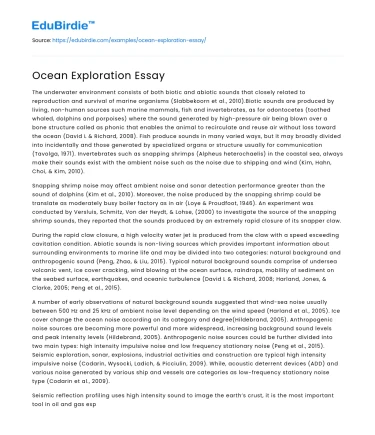The underwater environment consists of both biotic and abiotic sounds that closely related to reproduction and survival of marine organisms (Slabbekoorn et al., 2010).Biotic sounds are produced by living, non-human sources such marine mammals, fish and invertebrates, as for odontocetes (toothed whaled, dolphins and porpoises) where the sound generated by high-pressure air being blown over a bone structure called as phonic that enables the animal to recirculate and reuse air without loss toward the ocean (David L & Richard, 2008). Fish produce sounds in many varied ways, but it may broadly divided into incidentally and those generated by specialized organs or structure usually for communication (Tavolga, 1971). Invertebrates such as snapping shrimps (Alpheus heterochaelis) in the coastal sea, always make their sounds exist with the ambient noise such as the noise due to shipping and wind (Kim, Hahn, Choi, & Kim, 2010).
Snapping shrimp noise may affect ambient noise and sonar detection performance greater than the sound of dolphins (Kim et al., 2010). Moreover, the noise produced by the snapping shrimp could be translate as moderately busy boiler factory as in air (Loye & Proudfoot, 1946). An experiment was conducted by Versluis, Schmitz, Von der Heydt, & Lohse, (2000) to investigate the source of the snapping shrimp sounds, they reported that the sounds produced by an extremely rapid closure of its snapper claw.
Save your time!
We can take care of your essay
- Proper editing and formatting
- Free revision, title page, and bibliography
- Flexible prices and money-back guarantee
During the rapid claw closure, a high velocity water jet is produced from the claw with a speed exceeding cavitation condition. Abiotic sounds is non-living sources which provides important information about surrounding environments to marine life and may be divided into two categories: natural background and anthropogenic sound (Peng, Zhao, & Liu, 2015). Typical natural background sounds comprise of undersea volcanic vent, ice cover cracking, wind blowing at the ocean surface, raindrops, mobility of sediment on the seabed surface, earthquakes, and oceanic turbulence (David L & Richard, 2008; Harland, Jones, & Clarke, 2005; Peng et al., 2015).
A number of early observations of natural background sounds suggested that wind-sea noise usually between 500 Hz and 25 kHz of ambient noise level depending on the wind speed (Harland et al., 2005). Ice cover change the ocean noise according on its category and degree(Hildebrand, 2005). Anthropogenic noise sources are becoming more powerful and more widespread, increasing background sound levels and peak intensity levels (Hildebrand, 2005). Anthropogenic noise sources could be further divided into two main types: high intensity impulsive noise and low frequency stationary noise (Peng et al., 2015). Seismic exploration, sonar, explosions, industrial activities and construction are typical high intensity impulsive noise (Codarin, Wysocki, Ladich, & Picciulin, 2009). While, acoustic deterrent devices (ADD) and various noise generated by various ship and vessels are categories as low-frequency stationary noise type (Codarin et al., 2009).
Seismic reflection profiling uses high intensity sound to image the earth’s crust, it is the most important tool in oil and gas exploration but can also applied for mapping of shallower underground structures such as buried valleys (Li & Zhao, 2014; Peng et al., 2015; Westbrook, 1991). According to Mondol (2010) seismic pulses for exploration survey could be generated out of these three ways, employing air-guns, vibrator or dynamite. Furthermore, he also reported that air-guns source is more functioning in marine acquisition while vibrator and dynamite are commonly used for land seismic survey. Therefore, in marine seismic survey, arrays of air-guns is the sound producing elements where it release a high pressure; specified volume of air that create a sound pressure wave from the expansion and contraction of the released air bubble (Hildebrand, 2005). Moreover, according to Hildebrand (2005) in oil and gas industry air guns arrays commonly involve 12 to 48 individual guns and operates at pressure of 2000 psi, and approximately dispersed over 400 m2 region.
Similarly, sonar the acronym for sound navigation and ranging is sound waves that helpful for exploring and mapping the ocean since it travels farther in the water compared to radar and light waves (NOAA, 2018). Sonar may be categorized into active sonar and passive sonar. Active sonar emit a high intensity pulse of sound wave into the water such as military sonar that cover broader frequency with higher source levels (Hildebrand, 2005; NOAA, 2018). Besides being applied for military and submarine, sonar also being designed for commercial fish industry, study of fish and invertebrate animals (Fornshell & Tesei, 2013). Construction activities can be very noisy, particular percussive pile driving of monopile foundations, these produce an impact sounds of considerable intensity above (Tougaard, Madsen, & Wahlberg, 2008).
Furthermore, they also reported that underwater noise from the operating turbines is produced and transmitted through the platform to the foundations from which it is radiated into the water, in normal condition the noise have a low intensity with energy concentrated at lower frequencies that means the sound may be noticeable to seals, odontocetes and fish at distances up to several kilometer from the source. Finally, source from ship and ports are the contributor to the increase of ambient sound of ocean. Humans are terrestrially bound and industrially driven by business-cost minimization, this mean the most efficient of moving raw material and goods are by ships that using shortest sea routes (David L & Richard, 2008).






 Stuck on your essay?
Stuck on your essay?

